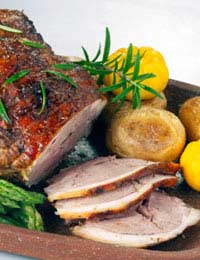Traditional Easter Dinner: Roast Lamb

The tradition of eating lamb at Easter is seen in many countries, particularly Eastern European ones, as a reminder of Christ, who is portrayed frequently in the Bible as the Lamb of God, who was crucified. Add to that the fact that Easter is a Spring holiday and new season’s lamb is available makes it an especially tempting main course for a traditonal dinner even for non-Christians!
Welsh Lamb
Wales has a long tradition of sheep-rearing and many people consider Welsh lamb to be the finest in the world. The weather – or maybe we should say the rain – in Wales produces good grass for the sheep, who roam freely over acres of rolling green hills. The majority of the sheep are raised on small farms that have been in the same family for generations. New Zealand lamb may have a larger share of the market but for the connoisseurs, lamb has to be Welsh. In fact, the EU has recognised the special character and unique quality of Welsh Lamb and awarded it the status of PGL (Protected Geographical Location), putting it on a par with the likes of Parma Ham.So for your Easter roast, first choose a leg of Welsh lamb from a quality butcher. Fresh lamb can be kept for 3 – 5 days in your fridge, provided the fridge isn’t overloaded and the temperature is maintained between 2 and 5 degrees. It should be kept covered, and on a bottom shelf to ensure no blood is able to drip onto other foods in the fridge.
Cooking the Lamb
Before you’re ready to cook the lamb, calculate the cooking time. Weigh the joint and allow 25 minutes per 450g plus 25 minutes. So if your joint weighs 1350g, cooking time will be 1 hour and 40 minutes. That will give you medium cooked lamb. It’s recommended that lamb should be served rare or medium but, if you prefer well done, cook for 30 minutes per 450g plus 30 minutes. After cooking you have to let the meat rest for at least 15 minutes to allow it to ‘relax’ and make it easier for carving, so include that in your timetable for the day.Pre-heat the oven to 180 degrees C, gas mark 4. Peel 2 large onions, cut into thick slices and lay in the base of a roasting tin. Wipe the lamb joint with kitchen towel and place on top of the sliced onions. If the meat is very lean, brush with olive oil. Stick a few small sprigs of rosemary into the meat and cook, uncovered, for the calculated time.
To be sure of cooking the meat perfectly to your requirement each time, use a food thermometer.
- Rare: 63–65 degrees C
- Medium: 70-75 degrees C
- Well done: 75-80 degrees C
Remove the lamb from the tin and place on a carving board. Cover with foil and allow to rest.
Sprinkle 2 tablespoons flour into the fat left in the pan with the onions. Stir well to make a paste. Gradually add ¾ pint lamb stock, ¼ pint red wine and 1 dessertspoon redcurrant jelly. Bring to the boil, stirring until the sauce thickens.
Slice the meat thickly and serve with sauce and some of the roasted onion from the cooking tin. Accompany with plenty of fresh seasonal vegetables and a glass of red wine!


Re: Recipe Ideas for Summer Baking
I thought this website was very Convenient because i had 7 year old guests round and had to entertain them. The recipies on this…
Re: Seasonal Veggie Party Food
I appreciate all your meals, but i just need simple meal for my colleagues, Cake never being the preferrable favourite for my…